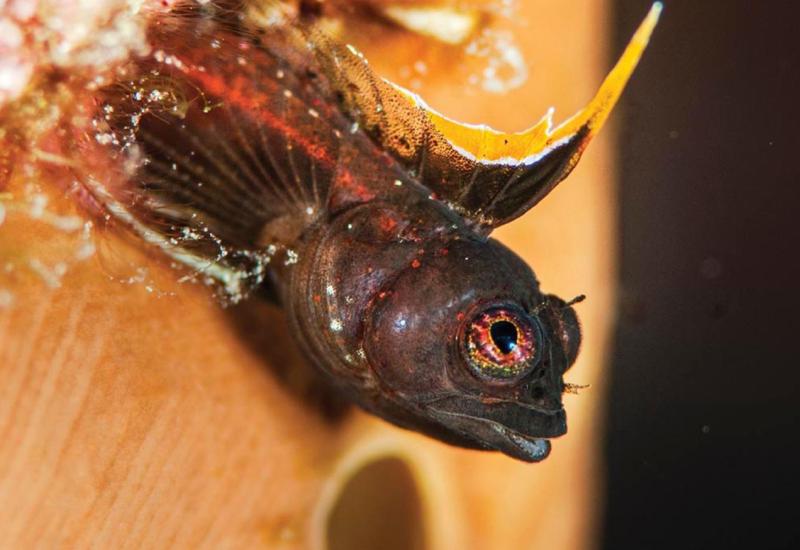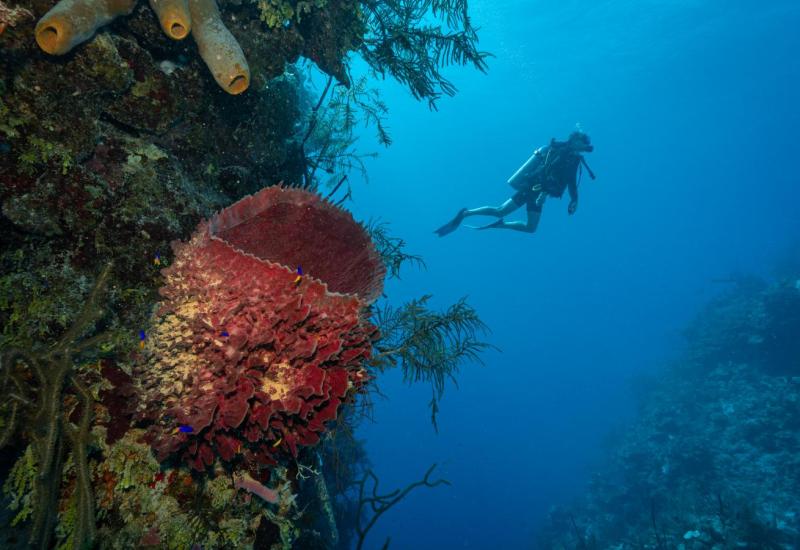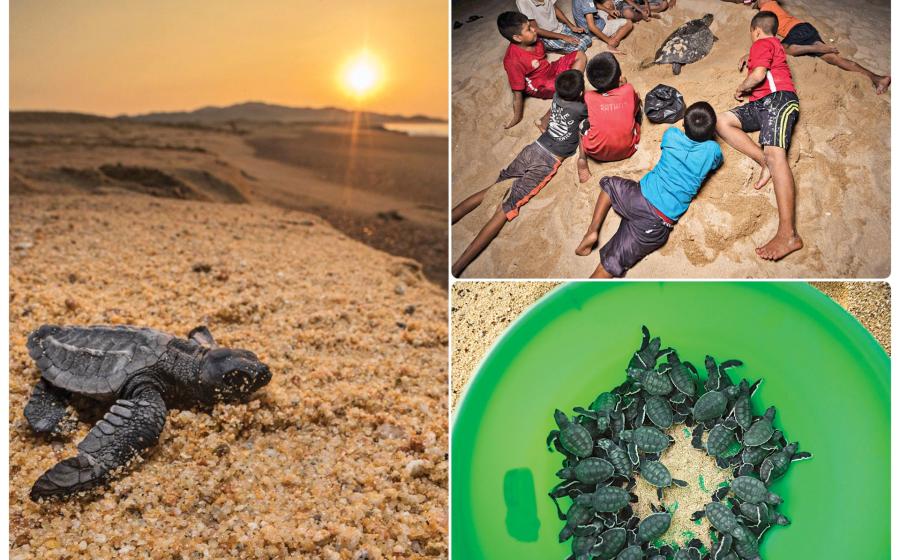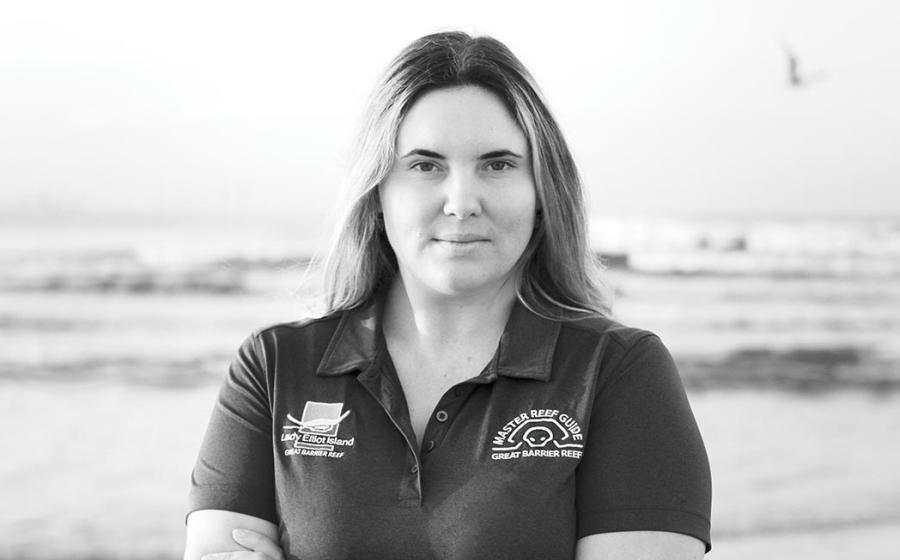Canary Islands Travel Guide

September 2001
By Alex Roslin

Rising out of the Atlantic Ocean just off the Moroccan coast, the Canary Islands have been shrouded in myth and legend for centuries. They are the inspiration for Homer's Elysian Fields, where the souls of dead heroes went to spend eternity. Greek legend also held that the archipelago of seven Canary Islands was the remains of Atlantis.
El Aquario
Today, the Canaries are being discovered for their excellent diving. The "seven roses of the Atlantic," as they are fondly called by locals, offer a blend of underwater features from Hawaii, the Red Sea, Africa and the Caribbean. All this, and the weather is great for diving year-round.
Tenerife: Las Galletas
Playa de las Vistas
Our first stop in the Canary Islands was Las Galletas, a sleepy town on the bone-dry south shore of the largest island, Tenerife. Las Galletas is Tenerife's most popular diving destination, but it is mostly free of the European tourists who swarm the nearby beach resorts. Known as the Costa del Silencio, the south coast is sheltered from the waves and winds that blast the north.
We suited up on the beach for a shore dive at Playa de las Vistas. Vis hit a respectable 90 feet once we cleared the beach, but our Belgian guide assured us it was usually better. We soon found ourselves in a jungle of sea life, including squadrons of trunkfish, barracuda, needlefish, starfish, squid and yellow-striped bass. A large moray eel tailed us like a suspicious security guard.
Playa de las Vistas is also a popular night-dive locale, featuring the usual night prowlers--octopus, cuttlefish, barracuda--as well as green phosphorescence.
At 74 degrees, the water was a relief from the hot morning sun--but a tad too cold to support Caribbean-style corals. Instead, the Canaries feature a combination of the volcanic underwater architecture of Hawaii--complete with mazes of grottoes, caves, undersea mountains and canyons--and Atlantic crosscurrents that bring together a wide range of sea creatures.

A balance of trade winds and warm currents has blessed the Canaries with a year-round temperate climate that inspired the nickname "islands of the eternal spring." This means divers will find a revolving selection of migrating species that tour past the Canaries throughout the year.
There are three types of marine life here--big cold-water Atlantic critters like manta rays and sea turtles, Red Sea-style tropical creatures like sand eels, striped red mullet and glass-eye, and Mediterranean marine life such as blacktail cumber.
At El Aquario, we were able to get up close and personal with some of these specimens. We picked up a bag of sardines at a Las Galletas beachfront fish market and a Zodiac took us a couple of hundred yards into the bay. Vis was good again--90 feet. As I took some time to equalize, I could see the dive guide and my wife Rhonda touch down on the white sand floor 60 feet below. They were already surrounded by a blizzard of friendly stingrays and fish.
The dozen or so rays circled excitedly, rubbing their soft wings against us. Soon we were joined by two six-foot-wide mantas hungry for affection and sardines. They let us pet their black backs and white underbellies, exposing their gaping mouths.
The centerpiece of the underwater village was a small wreck of a fishing boat. A solitary moray eel poked its head out of a hole in the wreck wondering what all the fuss was about. The wreck is also home to a sea turtle locals call Isabelle. On our way back, we glided over large beds of black sea worms.
Bahia Amarilla
Our next dive, Bahia Amarilla (Yellow Bay), gave us a taste of the Canaries' unique underwater volcanic formations. Divers suit up on the rocks and fin out along the sandy bottom into the bay. The water was quite clear with a view out to 120 feet. A good 150 yards out, we came upon two massive columns of black volcanic rock the height of four-story buildings shooting up out of the sand. A third column stood some 80 yards beyond. The formations were covered with colorful flora and teemed with fish--flounder, sea worms, squid, another octopus, trumpetfish, reef fish, needlefish.

Tenerife: Los Gigantes
Los Chuchos (Stingray Village)
Los Gigantes are one of Tenerife's most famous attractions, with 1,500-foot hazel-blue cliffs shooting straight up out of the ocean. Dive sites feature craggy volcanic caves, caverns and tunnels that are home to octopus, shoals of grunts, groupers, sponges, anemones and gorgonians. One favorite site called Stingray Village, or Los Chuchos, is home to a gaggle of stingrays and eagle rays, plus jacks, barracuda and tuna.
Atlantis
A site called Atlantis features a triangular platform of basalt rock consisting of hexagonal crystals. Some of the crystals have fallen away to resemble the ruins of an ancient city (hence the name of the spot). They are a photo-perfect backdrop for swarms of fish and red and yellow gorgonians.
Masca Bay
Experienced divers can get a rare look at black coral at Masca Bay, about 30 minutes north by boat. You dive in the shadow of the massive cliffs to a drop-off that starts at 75 feet, then plummets to 150 feet. The wall is covered in black coral, and at the bottom are two small caves. They are home to several swallowtail sea perch and fangtooth morays. Large jacks and barracuda are also commonly sighted.
Tenerife: North Coast
The island's lush north slope is a different world. Only a 30-minute drive from the desert-like south shore, Tenerife's north coast catches lots of rain. The north also boasts little-known dive sites that pay off big for those willing to brave the stronger currents. Volcanic formations are the big draw--caves, chimneys, bridges, canyons, arches.
The Atlantik Divingcentre in Puerto de la Cruz is the only operation on this coast. Popular dives include the Cathedral, which features sheer walls going straight down and down and down. There is also a DC-3 wreck at El Sauzal about 90 feet down.
La Gomera
This tiny 12-mile-wide island is virtually untouched by tourism and is famous for its stunning volcanic landscapes. Below the waves, La Gomera is known for an abundance of big fish and impressive rock formations. A popular boat dive called Cascante features a cavern at 45 feet, home to many different critters. Divers tour several other formations, then proceed through an arcade before turning back.
Fuerteventura and Lanzarote

One of the easternmost of the Canary Islands, Fuerteventura is blessed with Europe's most famous white-sand beaches. Among the many sites here is El Bajon del Rio where divers can experience more freaky underwater formations, including a row of three 15-foot-high rocks shaped like toadstools. The heads are covered with blue and green algae and underneath lurk schools of small fish, white and zebra bream, Turkish wrasse, parrotfish and barracuda.
Getting There: The Canaries still lack direct flights from North America. Flights are now available from New York that last 11 to 15 hours, including a stop in Madrid, but be prepared for an odyssey of up to 40 hours from some North American locations.
Nearby Lanzarote, the easternmost Canary Island, is like a moonscape--there are virtually no trees and the island is covered by a thick, craggy blanket of black lava. This pear-shaped island was transformed by great volcanic eruptions from 1730 to 1736, when over 100 volcanoes rose up, covering 20 square miles.
A favorite spot for more experienced divers is the Los Erizos shipwreck yard. The location features eight wrecks in 60 to 90 feet of water and has been designated a marine conservation site. The wrecks support rich marine life, including sardines, pinfish, Turkish wrasse, emperor fish, arrow crabs, large groupers and sometimes large stingrays and tuna (plus angel sharks in winter).
Sightseeing in the Canaries
German naturalist and traveler Alexander von Humboldt called the Canary Islands the most beautiful place on earth, and it's not hard to see why. Even hard-core divers will want to take some time to explore the islands' topside vistas.
At the center of each island is a rising crescendo of volcanoes, great for a sightseeing drive or hiking. El Teide, at the center of Tenerife, is surrounded by a 10-mile-wide crater with a wild lunar landscape. Bring lots of film--you'll be snapping like crazy. The night sky in the mountains is also spectacular.
Other must-sees are the sleepy colonial-era towns, labyrinthine natural caves--one extending 15 miles--and the untouched countryside. The islands attract twice as many tourists as the Caribbean, but 40 percent of the surface area is set aside for conservation. This, plus the fact that most tourists are concentrated in small pockets on the two largest islands, means lots of elbow room.
In fact, the Canaries are often said to be lost in time somewhere between modern Europe and the time of the original cave-dwelling inhabitants, known as Guanches, famous for their whistling language and fierce resistance to the Spanish conquistadores. The islands still have hundreds of old Guanche caves carved into cliffsides, as well as Guanche-era pyramids.
Dive In: Canary Islands

Geography: The Canary Islands group consists of seven large islands and six smaller islets located about 650 miles southwest of Spain. The Canaries stretch about 300 miles from east to west, with the easternmost island 60 miles off the coast of Morocco.
Time Zone: The Canaries are one hour behind Greenwich Mean Time and follow daylight saving time. That means they're five hours ahead of New York and eight hours ahead of L.A.
Climate: Weather barely changes throughout the year, ranging from a daily average of 65F in winter to 75F in summer, but rising to 95F in the afternoon. There is no rainy season. The islands have wildly differing climate zones--wet, lush and a little cooler in the north, desert-like in the south. The mountains at the center of the islands have their own distinct climates--windy and cooler. Be prepared for a volcanic eruption every few hundred years.
Entry Requirements: Passport required for U.S. and Canadian citizens. No airport charges.
Language: Spanish, but English is widely spoken.
Currency: Spanish pesetas. Credit cards are widely accepted and there are plenty of ATMs.
Electricity: 220 volts.
Water Conditions: Water temps range from 74F to 77F in the summer, and 65F to 68F in winter, with visibility
averaging 75 to 120 feet. Conditions are rougher on the islands' north coasts.
Recompression Chambers: There are chambers located in Tenerife, Gran Canaria and Fuerteventura.
Canary Islands Dive Operators
Aqua-Marina Dive Center (Tenerife), 011-34-922-797944
Atlantic Divers (Tenerife), 011-34-922-735509
Blue Explorers Dive Centers (Gran Canaria and Tenerife), 011-34-928-774539
Calipso Diving (Lanzarote), 011-34-928-590879
Divingcenter Atlantik (Tenerife), 011-34-922-362801
Fisch & Co. Diving School (La Gomera), 011-34-922-805688
Gomera Dive Resort (La Gomera), 011-34-922-895902
Los Gigantes Diving Centre (Tenerife), 011-34-922-860431
Safaridiving (Lanzarote), 011-34-928-511992
TRENDive-Center (Fuerteventura), 011-34-928-867290

September 2001
By Alex Roslin
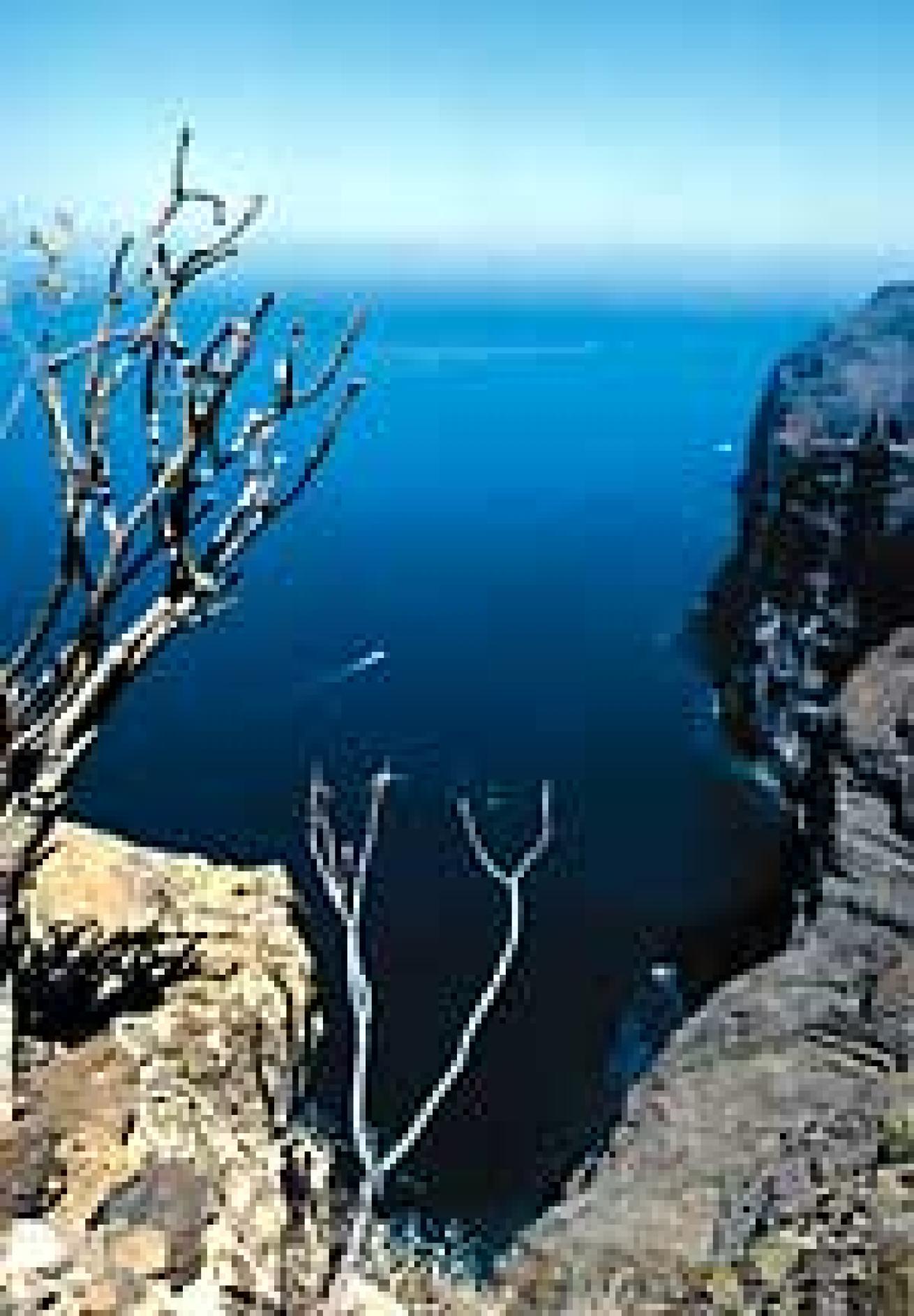
Rising out of the Atlantic Ocean just off the Moroccan coast, the Canary Islands have been shrouded in myth and legend for centuries. They are the inspiration for Homer's Elysian Fields, where the souls of dead heroes went to spend eternity. Greek legend also held that the archipelago of seven Canary Islands was the remains of Atlantis.
Today, the Canaries are being discovered for their excellent diving. The "seven roses of the Atlantic," as they are fondly called by locals, offer a blend of underwater features from Hawaii, the Red Sea, Africa and the Caribbean. All this, and the weather is great for diving year-round.
Tenerife: Las Galletas
Playa de las Vistas
Our first stop in the Canary Islands was Las Galletas, a sleepy town on the bone-dry south shore of the largest island, Tenerife. Las Galletas is Tenerife's most popular diving destination, but it is mostly free of the European tourists who swarm the nearby beach resorts. Known as the Costa del Silencio, the south coast is sheltered from the waves and winds that blast the north.
We suited up on the beach for a shore dive at Playa de las Vistas. Vis hit a respectable 90 feet once we cleared the beach, but our Belgian guide assured us it was usually better. We soon found ourselves in a jungle of sea life, including squadrons of trunkfish, barracuda, needlefish, starfish, squid and yellow-striped bass. A large moray eel tailed us like a suspicious security guard.
Playa de las Vistas is also a popular night-dive locale, featuring the usual night prowlers--octopus, cuttlefish, barracuda--as well as green phosphorescence.
At 74 degrees, the water was a relief from the hot morning sun--but a tad too cold to support Caribbean-style corals. Instead, the Canaries feature a combination of the volcanic underwater architecture of Hawaii--complete with mazes of grottoes, caves, undersea mountains and canyons--and Atlantic crosscurrents that bring together a wide range of sea creatures.
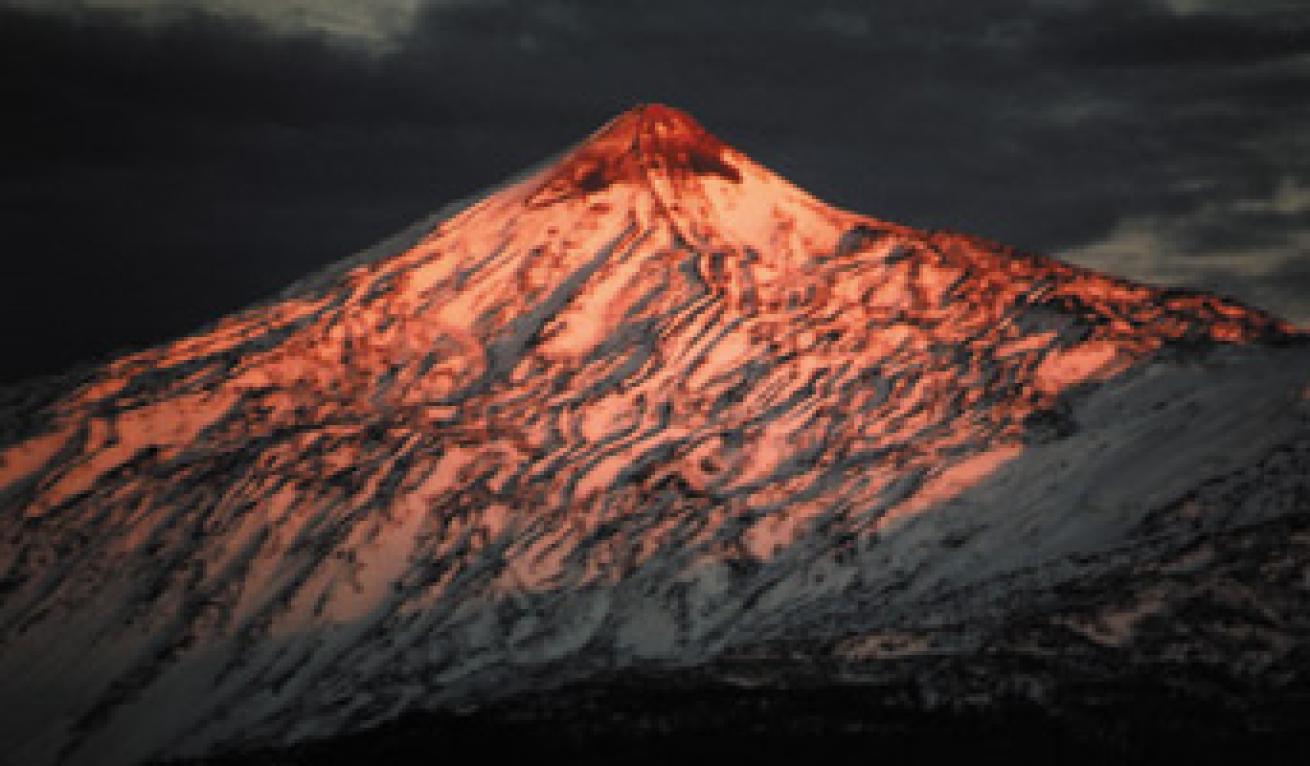
El Aquario
A balance of trade winds and warm currents has blessed the Canaries with a year-round temperate climate that inspired the nickname "islands of the eternal spring." This means divers will find a revolving selection of migrating species that tour past the Canaries throughout the year.
There are three types of marine life here--big cold-water Atlantic critters like manta rays and sea turtles, Red Sea-style tropical creatures like sand eels, striped red mullet and glass-eye, and Mediterranean marine life such as blacktail cumber.
At El Aquario, we were able to get up close and personal with some of these specimens. We picked up a bag of sardines at a Las Galletas beachfront fish market and a Zodiac took us a couple of hundred yards into the bay. Vis was good again--90 feet. As I took some time to equalize, I could see the dive guide and my wife Rhonda touch down on the white sand floor 60 feet below. They were already surrounded by a blizzard of friendly stingrays and fish.
The dozen or so rays circled excitedly, rubbing their soft wings against us. Soon we were joined by two six-foot-wide mantas hungry for affection and sardines. They let us pet their black backs and white underbellies, exposing their gaping mouths.
The centerpiece of the underwater village was a small wreck of a fishing boat. A solitary moray eel poked its head out of a hole in the wreck wondering what all the fuss was about. The wreck is also home to a sea turtle locals call Isabelle. On our way back, we glided over large beds of black sea worms.
Bahia Amarilla
Our next dive, Bahia Amarilla (Yellow Bay), gave us a taste of the Canaries' unique underwater volcanic formations. Divers suit up on the rocks and fin out along the sandy bottom into the bay. The water was quite clear with a view out to 120 feet. A good 150 yards out, we came upon two massive columns of black volcanic rock the height of four-story buildings shooting up out of the sand. A third column stood some 80 yards beyond. The formations were covered with colorful flora and teemed with fish--flounder, sea worms, squid, another octopus, trumpetfish, reef fish, needlefish.
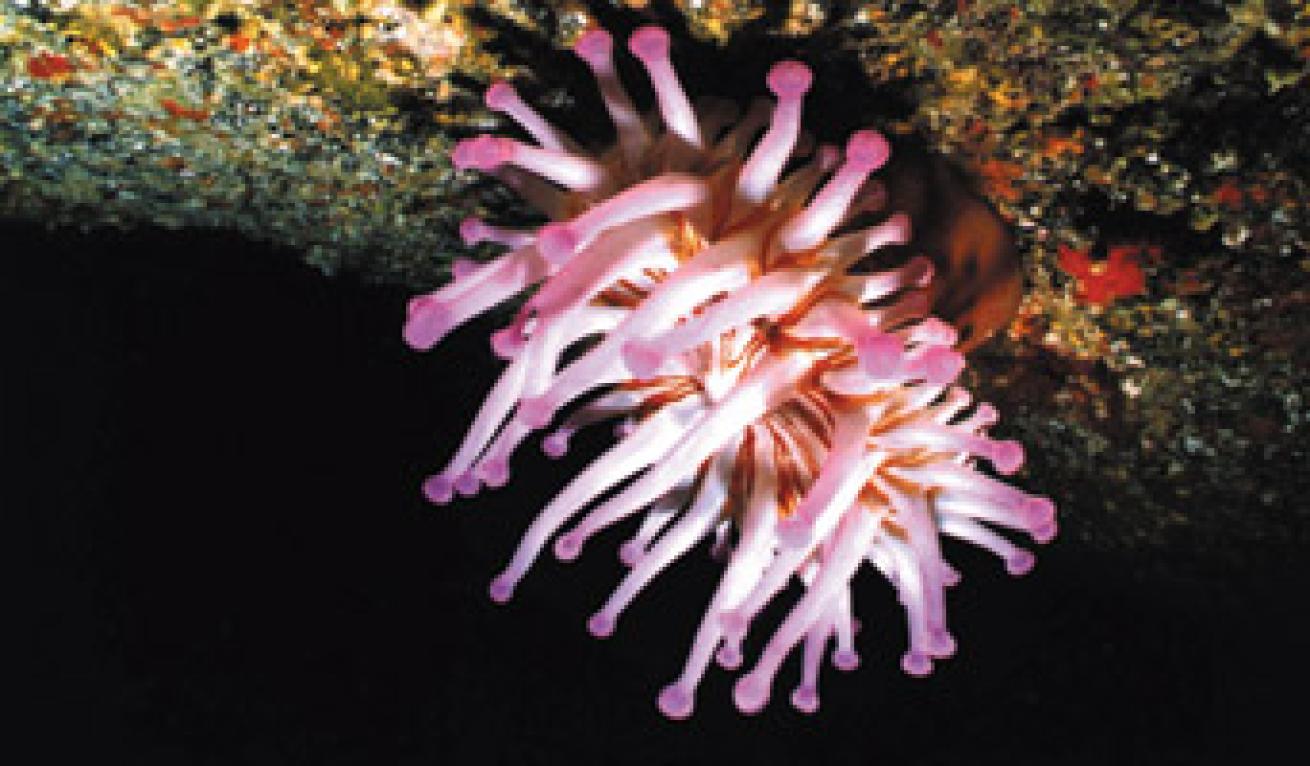
Tenerife: Los Gigantes
Los Chuchos (Stingray Village)
Los Gigantes are one of Tenerife's most famous attractions, with 1,500-foot hazel-blue cliffs shooting straight up out of the ocean. Dive sites feature craggy volcanic caves, caverns and tunnels that are home to octopus, shoals of grunts, groupers, sponges, anemones and gorgonians. One favorite site called Stingray Village, or Los Chuchos, is home to a gaggle of stingrays and eagle rays, plus jacks, barracuda and tuna.
Atlantis
A site called Atlantis features a triangular platform of basalt rock consisting of hexagonal crystals. Some of the crystals have fallen away to resemble the ruins of an ancient city (hence the name of the spot). They are a photo-perfect backdrop for swarms of fish and red and yellow gorgonians.
Masca Bay
Experienced divers can get a rare look at black coral at Masca Bay, about 30 minutes north by boat. You dive in the shadow of the massive cliffs to a drop-off that starts at 75 feet, then plummets to 150 feet. The wall is covered in black coral, and at the bottom are two small caves. They are home to several swallowtail sea perch and fangtooth morays. Large jacks and barracuda are also commonly sighted.
Tenerife: North Coast
The island's lush north slope is a different world. Only a 30-minute drive from the desert-like south shore, Tenerife's north coast catches lots of rain. The north also boasts little-known dive sites that pay off big for those willing to brave the stronger currents. Volcanic formations are the big draw--caves, chimneys, bridges, canyons, arches.
The Atlantik Divingcentre in Puerto de la Cruz is the only operation on this coast. Popular dives include the Cathedral, which features sheer walls going straight down and down and down. There is also a DC-3 wreck at El Sauzal about 90 feet down.
La Gomera
This tiny 12-mile-wide island is virtually untouched by tourism and is famous for its stunning volcanic landscapes. Below the waves, La Gomera is known for an abundance of big fish and impressive rock formations. A popular boat dive called Cascante features a cavern at 45 feet, home to many different critters. Divers tour several other formations, then proceed through an arcade before turning back.
Fuerteventura and Lanzarote
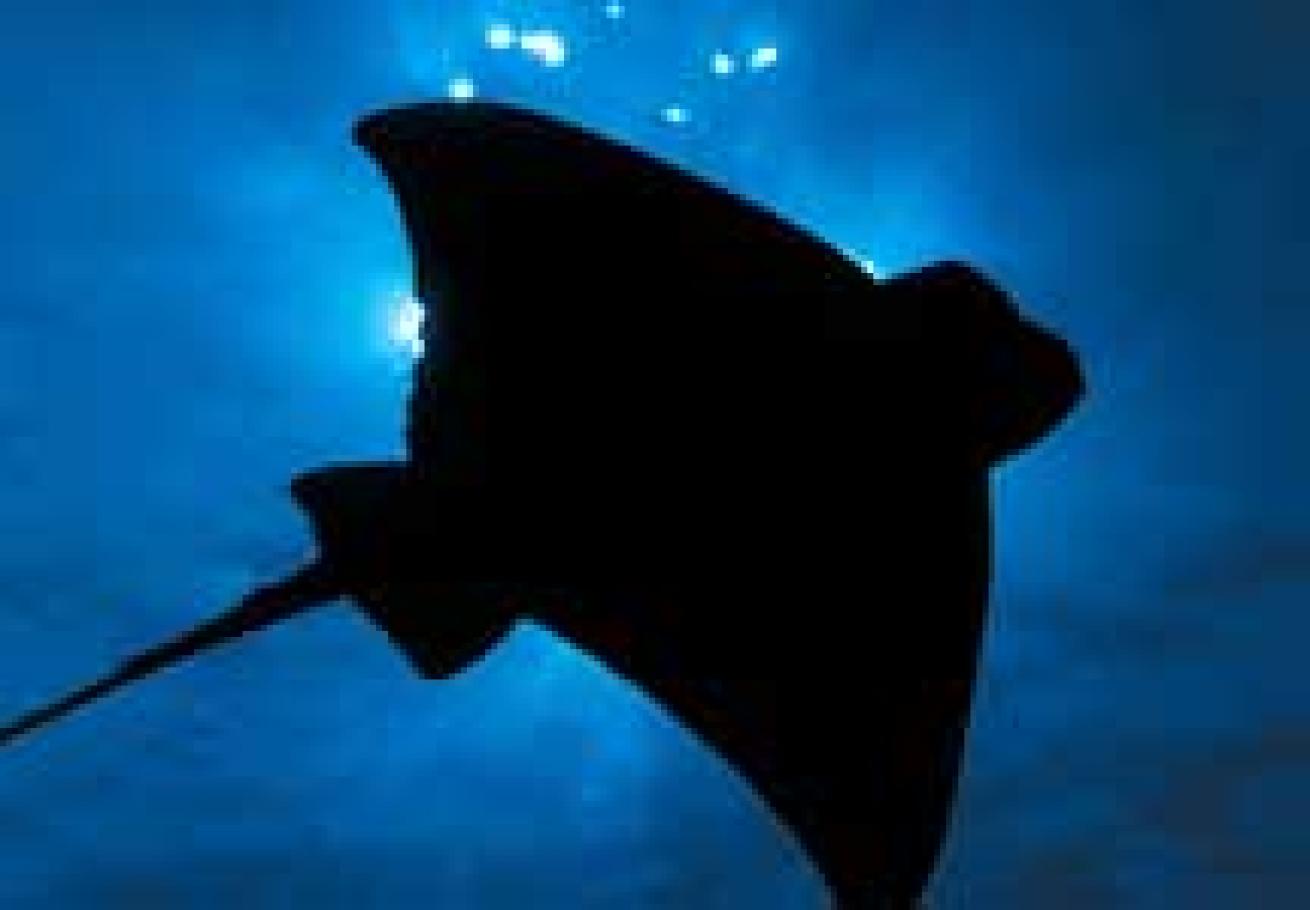
One of the easternmost of the Canary Islands, Fuerteventura is blessed with Europe's most famous white-sand beaches. Among the many sites here is El Bajon del Rio where divers can experience more freaky underwater formations, including a row of three 15-foot-high rocks shaped like toadstools. The heads are covered with blue and green algae and underneath lurk schools of small fish, white and zebra bream, Turkish wrasse, parrotfish and barracuda.
Nearby Lanzarote, the easternmost Canary Island, is like a moonscape--there are virtually no trees and the island is covered by a thick, craggy blanket of black lava. This pear-shaped island was transformed by great volcanic eruptions from 1730 to 1736, when over 100 volcanoes rose up, covering 20 square miles.
A favorite spot for more experienced divers is the Los Erizos shipwreck yard. The location features eight wrecks in 60 to 90 feet of water and has been designated a marine conservation site. The wrecks support rich marine life, including sardines, pinfish, Turkish wrasse, emperor fish, arrow crabs, large groupers and sometimes large stingrays and tuna (plus angel sharks in winter).
Sightseeing in the Canaries
German naturalist and traveler Alexander von Humboldt called the Canary Islands the most beautiful place on earth, and it's not hard to see why. Even hard-core divers will want to take some time to explore the islands' topside vistas.
At the center of each island is a rising crescendo of volcanoes, great for a sightseeing drive or hiking. El Teide, at the center of Tenerife, is surrounded by a 10-mile-wide crater with a wild lunar landscape. Bring lots of film--you'll be snapping like crazy. The night sky in the mountains is also spectacular.
Other must-sees are the sleepy colonial-era towns, labyrinthine natural caves--one extending 15 miles--and the untouched countryside. The islands attract twice as many tourists as the Caribbean, but 40 percent of the surface area is set aside for conservation. This, plus the fact that most tourists are concentrated in small pockets on the two largest islands, means lots of elbow room.
In fact, the Canaries are often said to be lost in time somewhere between modern Europe and the time of the original cave-dwelling inhabitants, known as Guanches, famous for their whistling language and fierce resistance to the Spanish conquistadores. The islands still have hundreds of old Guanche caves carved into cliffsides, as well as Guanche-era pyramids.
Dive In: Canary Islands
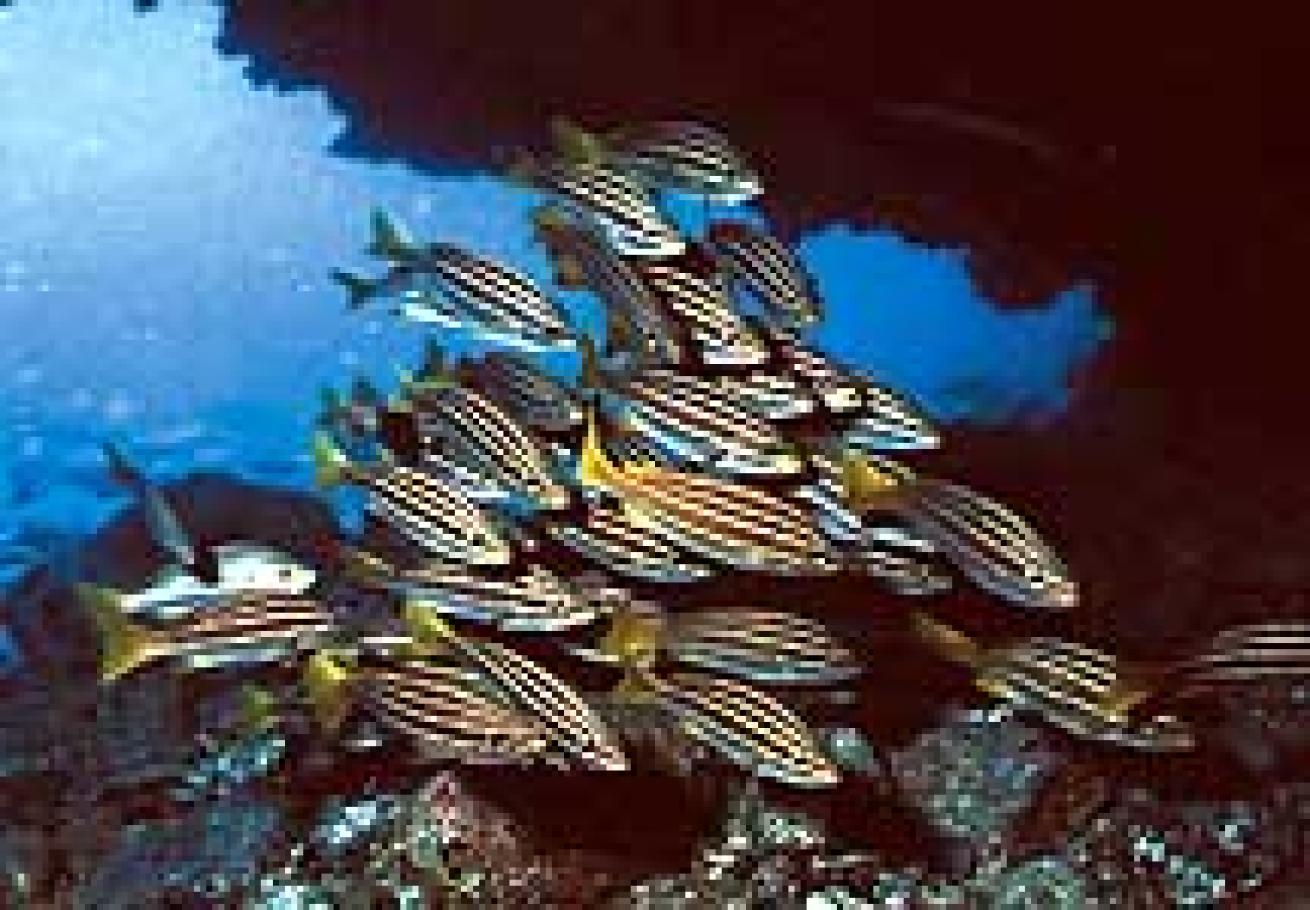
Getting There: The Canaries still lack direct flights from North America. Flights are now available from New York that last 11 to 15 hours, including a stop in Madrid, but be prepared for an odyssey of up to 40 hours from some North American locations.
Geography: The Canary Islands group consists of seven large islands and six smaller islets located about 650 miles southwest of Spain. The Canaries stretch about 300 miles from east to west, with the easternmost island 60 miles off the coast of Morocco.
Time Zone: The Canaries are one hour behind Greenwich Mean Time and follow daylight saving time. That means they're five hours ahead of New York and eight hours ahead of L.A.
Climate: Weather barely changes throughout the year, ranging from a daily average of 65F in winter to 75F in summer, but rising to 95F in the afternoon. There is no rainy season. The islands have wildly differing climate zones--wet, lush and a little cooler in the north, desert-like in the south. The mountains at the center of the islands have their own distinct climates--windy and cooler. Be prepared for a volcanic eruption every few hundred years.
Entry Requirements: Passport required for U.S. and Canadian citizens. No airport charges.
Language: Spanish, but English is widely spoken.
Currency: Spanish pesetas. Credit cards are widely accepted and there are plenty of ATMs.
Electricity: 220 volts.
Water Conditions: Water temps range from 74F to 77F in the summer, and 65F to 68F in winter, with visibility
averaging 75 to 120 feet. Conditions are rougher on the islands' north coasts.
Recompression Chambers: There are chambers located in Tenerife, Gran Canaria and Fuerteventura.
Canary Islands Dive Operators
Aqua-Marina Dive Center (Tenerife), 011-34-922-797944
Atlantic Divers (Tenerife), 011-34-922-735509
Blue Explorers Dive Centers (Gran Canaria and Tenerife), 011-34-928-774539
Calipso Diving (Lanzarote), 011-34-928-590879
Divingcenter Atlantik (Tenerife), 011-34-922-362801
Fisch & Co. Diving School (La Gomera), 011-34-922-805688
Gomera Dive Resort (La Gomera), 011-34-922-895902
Los Gigantes Diving Centre (Tenerife), 011-34-922-860431
Safaridiving (Lanzarote), 011-34-928-511992
TRENDive-Center (Fuerteventura), 011-34-928-867290


